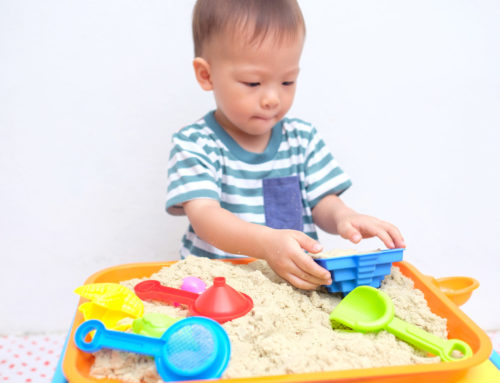Reviewed by Melissa Hendrickson, RN and Director of Health Services at Penfield Children’s Center.
What is a feeding tube?
A temporary or removable feeding tube is a small, soft, hollow, plastic tube placed through the nose (NG/NJ) or mouth (OG) into the stomach or intestine. These tubes are used to provide feedings and medications until the baby or child can take them by mouth.
A long-term feeding tube is called a gastrostomy tube (G-tube) or a jejunostomy tube (J-tube). Both are tubes inserted through the abdomen that deliver nutrition directly to the stomach or intestine. A child can have both a gastrostomy and jejunostomy tube at the same time.
Using G-tubes and J-tubes, doctors can make sure kids who are having trouble eating get the fluid and calories they need to grow.
Why might an infant or child need a feeding tube?
Common conditions that might require a child to have a feeding tube inserted include:
- Congenital (present from birth) abnormalities of the mouth, esophagus, stomach or intestines
- Sucking and swallowing disorders, which are often related to prematurity, brain injury, developmental delay or certain neuromuscular conditions, including severe cerebral palsy
- Failure to thrive, which is a general diagnosis that refers to a child’s inability to gain weight and grow appropriately
- Extreme difficulty taking medicines
How is the feeding tube placed?
A temporary feeding tube is gently placed through the nose or mouth into the stomach. It is usually taped in place. An x-ray can confirm correct placement, if needed. In babies and children with feeding difficulties, the tip of the tube may be placed past the stomach into the small intestine to provide slower, continuous feedings.
Placing a G-tube or J-tube is a bit more challenging, but still a common procedure. A doctor inserts the tube surgically into the abdomen at a hospital. This procedure typically takes 30 to 45 minutes. After spending one or two days in the hospital, kids who have had a G-tube or J-tube inserted can resume their normal activities fairly soon after the incision has healed. An x-ray is used to confirm correct placement of both feeding tubes. Sometimes, it is replaced by a button, called a Bard Button or MIC-KEY, three to eight weeks after surgery.
What are the risks of a feeding tube?
Feeding tubes are generally very safe and effective. However, even if it is placed gently, a feeding tube can irritate the nose, mouth or stomach and cause some (usually minor) bleeding. If placed in the nose, it may cause some nasal stuffiness and occasionally a nasal infection. If the tube is placed incorrectly and is not in the proper position, the baby may have problems with:
- An abnormally slow heart rate (bradycardia)
- Breathing
- Spitting up
My child needs a feeding tube, how do I use it?
You will quickly get used to feeding your child using the tube or button. There are multiple ways to feed using the system: the syringe method, the gravity method and the use of a feeding pump. Each method is described in detail below.
Your doctor will tell you the right mix of formula or blended feedings to use, and how often to feed your child. Have this food ready at room temperature before you start by taking it out of the refrigerator for about 30 to 40 minutes. Do not add more formula or solid foods until you talk to your child’s doctor.
Feeding bags should be changed every 24 hours. All of the equipment can be cleaned with hot, soapy water and hung up to dry. Remember to wash your hands regularly to prevent the spread of germs.
How do I care for the tube site?
You will need to clean your child’s skin around the G-tube one to three times per day with mild soap and water. Try to remove any drainage or crusting on the skin and tube. Be gentle. Dry the skin well with a clean towel. The skin should heal in two to three weeks.
Your doctor may want you to put a special absorbent pad or gauze around the G-/J-tube site. This should be changed at least once daily, or if it becomes wet or soiled. Do not use any ointments, powders or sprays around the G-tube unless told to do so by your health care provider.
Tips for feeding time with your child:
- Make sure your child is sitting up either in your arms or in a high chair.
- Feeding time is a social, happy time. Make it pleasant and fun. Your child will enjoy gentle talk and play.
- Try to keep your child from pulling on the tube by giving him or her something to do or play with during feedings.
- Since your child may not be using his/her mouth, your doctor will discuss other ways to help your child suck and develop oral-motor skills.
Feeding your child with the gravity method:
Your doctor or nurse will show you the best way to use your system without getting air into the tubes. Follow these steps first:
- Wash your hands
- Gather your supplies (feeding set, extension set for a G-/J-button or MIC-KEY if needed, measuring cup with spout, room temperature food, and a cup of water).
- Check that the formula or food is room temperature by putting a few droplets on your wrist.
- If your child has a G-/J-tube, close the clamp on the feeding tube.
- Hang the bag high on a hook and squeeze the drip chamber below the bag to fill it halfway with food.
- Next, open the clamp so the food fills the long tube and there is no air left in the tube.
- Close the clamp.
- Insert the catheter into the G-/J-tube.
- Open toward the clamp and adjust the feeding rate, following your health care provider’s instructions.
- When you are finished feeding, your nurse may recommend that you add water to the tube to flush it out.
- G-/J-tubes will then need to be clamped at the tube, and the feeding system will need to be removed.
If you are using a G-/J-button, or MIC-KEY, system:
- Attach the feeding tube to the feeding system first, then fill it with formula or food.
- Release the clamp when you are ready to adjust the feeding rate, following your health care provider’s instructions.
- When you are finished feeding, your nurse may recommend that you add water to the tube to flush it out.
Feeding your child with the syringe method:
Your nurse will teach you the best way to use your system without getting air into the tubes. Follow these steps:
- Wash your hands.
- Gather your supplies (a syringe, feeding tube, extension set for a G-/J-button or MIC-KEY if needed, measuring cup with spout, room temperature food, water and clamp).
- Check that the formula or food is room temperature.
If your child has a G-/J-tube:
- Insert the syringe into the open end of the feeding tube.
- Pour the formula into the syringe until it is half full and unclamp the tube.
If you are using a G-button, or MIC-KEY, system:
- Open the flap and insert the bolus feeding tube.
- Insert the syringe into the open end of the extension set and clamp the extension set.
- Pour the food into the syringe until it is half full. Unclamp the extension set briefly to fill it full of food and then close the clamp again.
- Open the button flap and connect the extension set to the button.
- Unclamp the extension set to begin feeding.
- Hold the tip of the syringe no higher than your child’s shoulders. If the food is not flowing, squeeze the tube and pull downward to bring the food down.
When you are finished feeding, your nurse may recommend that you add water to the tube to flush it out. The G-/J-tubes will then need to be clamped at the tube and the feeding system, and removed. For a G-/J-button or MIC-KEY, you’ll close the clamp and then remove the tube.
Bloating after Feeding
If your child’s belly becomes hard or swollen after a feeding, try venting or “burping,” the tube or button:
- Attach an empty syringe to the G-tube and unclamp it to allow air to flow out.
- Attach the extension set to the MIC-KEY button and open the tube to the air to release.
- Ask your doctor for a special decompression tube for “burping” the button.
How do I provide medications using the tube?
At some point, you may need to provide medicine for your child through the tube. Follow these guidelines:
- The medicine should be liquid, or finely crushed and dissolved in water, so the tube doesn’t get blocked. Check with your doctor or pharmacist on how to do this.
- Always flush the tube with a small amount of water between medicines. This will make sure that all the medicine goes in the stomach and is not left in the feeding tube.
- Never mix medicines.
- Always follow the doctor’s instructions on the best methods to give medications.
When should I call the doctor?
Call your child’s nurse or doctor if your child:
- Seems hungry after the feeding
- Has diarrhea after feedings
- Has a hard and swollen belly after feedings
- Seems to be in pain
- Has changes in his/her condition
- Is on new medication
- Is constipated and passing hard, dry stools
Also call the doctor if:
- The feeding tube has come out and you do not know how to replace it.
- There is leakage around the tube or system.
- There is redness or irritation on the skin around the tube.
Information taken from:
“About G-tubes.” Kidshealth. March 2013. Nemours. 3 May 2013. <http://kidshealth.org/parent/system/surgery/g_tube.html>
“Feeding tube – infants.” MedlinePlus. 22 March 2013. U.S. National Library of Medicine. 3 May 2013. <http://www.nlm.nih.gov/medlineplus/ency/article/007235.htm>
“Gastrostomy feeding tube – bolus” MedlinePlus. 22 March 2013. U.S. National Library of Medicine. 3 May 2013. <http://www.nlm.nih.gov/medlineplus/ency/patientinstructions/000165.htm>







